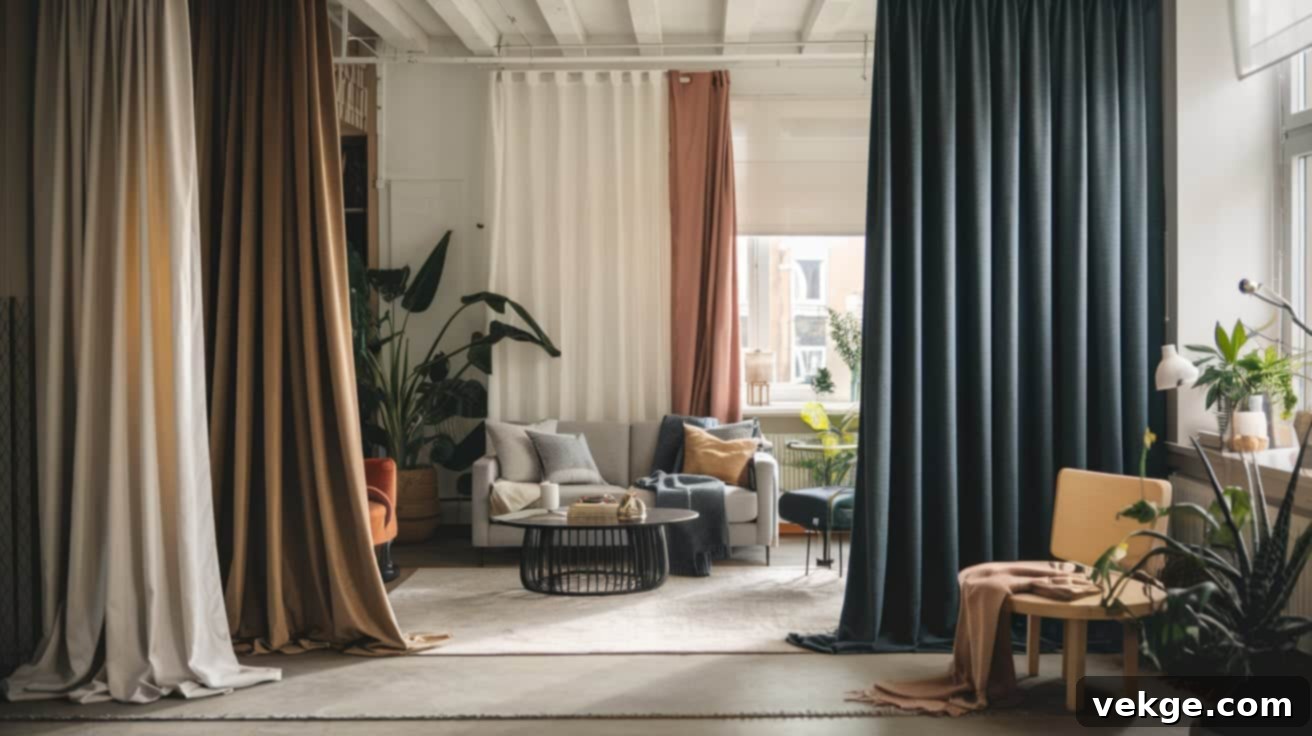The Ultimate Guide to Curtain Length: Should Your Drapes Touch the Floor?
The question of whether curtains should touch the floor is a classic dilemma that often leaves homeowners pondering during the decorating process. It’s a detail that might seem minor, but the chosen length of your window treatments can dramatically impact the overall feel, style, and functionality of a room.
While personal preference certainly plays a significant role in every design choice, established interior design trends generally lean towards curtains that reach the floor. This approach creates a more polished, integrated, and finished look, enhancing the vertical lines of a room and often making the ceiling appear higher.
However, the concept of “touching the floor” isn’t a one-size-fits-all rule. Curtains can meet the floor in various ways, each offering a distinct aesthetic and practical advantage. From hovering precisely above the floor to gently kissing it, or even creating a luxurious cascade of fabric, the nuances of curtain length are worth exploring.
In this comprehensive guide, we’ll delve into all your curtain length options. We’ll help you understand the characteristics of each style and empower you to choose the best one, meticulously tailored to your room’s purpose, the fabric you select, and your specific lifestyle needs. Get ready to transform your windows and elevate your home decor!
Should Curtains Be Touching the Floor? Understanding the Impact of Length
The simple answer to “Should curtains be touching the floor?” is often “yes,” but with important caveats. The ideal length largely depends on the specific look and functionality you aim to achieve. Each method of curtains meeting (or not quite meeting) the floor conveys a different message and serves a distinct purpose within your interior design scheme.
For a clean, contemporary, and highly streamlined appearance, curtains that hover just above the floor are often preferred. This modern approach creates a crisp line, giving a room a minimalist and uncluttered feel. It’s an excellent choice for preventing fabric from dragging or getting soiled, making it ideal for high-traffic areas or homes with pets and children.
If your preference leans towards a more traditional, comfortable, and inviting look, curtains that gently rest or “break” on the floor are ideal. This style offers a softer aesthetic, adding a touch of relaxed elegance without excessive pooling. It’s versatile enough for many rooms and provides a subtle, refined finish that feels both polished and lived-in.
Conversely, in more formal or opulent settings, curtains that extend noticeably past the floor, creating a slight to generous “puddle” of fabric, can add a significant touch of refinement, grandeur, and dramatic excellence. This luxurious style is all about creating a statement, evoking a sense of lavishness and old-world charm. It’s often chosen for rooms where the curtains are more decorative than functional, or where a dramatic flair is desired.
Ultimately, the decision is a blend of aesthetic vision, practical considerations, and personal taste. Let’s explore these options in detail to help you make an informed choice.
Tips for Different Curtain Lengths: Choosing Your Perfect Style
Selecting the right curtain length is a crucial step in window treatment design. Here, we’ll break down the most popular length categories and provide actionable tips to help you decide which one is best suited for your home.
1. Float Length (Hovering Just Above the Floor)

Float length refers to curtains that hang approximately 1/2 inch to 1 inch above the floor. This precise measurement ensures the fabric never actually touches the ground, offering a remarkably clean, crisp, and minimalist look. It’s a hallmark of modern and contemporary interior design, where sleek lines and uncluttered aesthetics are highly valued.
This length works exceptionally well in interiors where you want the curtains to be highly functional and low-maintenance. By preventing the fabric from touching the floor, you eliminate concerns about dust accumulation, wear and tear, or interference with objects below, such as heating registers or furniture. It creates a sleek, streamlined appearance without any excess fabric dragging on the ground, making curtains easy to open and close smoothly.
Ideal For:
- Modern and Minimalist Interiors: Enhances a clean, uncluttered aesthetic.
- High-Traffic Areas: Living rooms, hallways, and dining rooms where curtains are frequently opened and closed.
- Homes with Pets or Children: Reduces the risk of tripping, damage, or soiling.
- Rooms with Radiators or Floor Vents: Prevents heat from being trapped behind the curtains, ensuring efficient heating.
- Kitchens and Bathrooms: Practical for spaces where hygiene and easy cleaning are priorities.
While sometimes perceived as less luxurious than longer styles, a well-executed float length can appear incredibly chic and intentional, contributing to a sharp, tailored finish.
2. Break Length (Gently Resting on the Floor)

Break length curtains are designed to rest gently on the floor, creating a subtle, elegant “break” or crease at the bottom. This usually means the fabric extends about 1/2 inch to 1 inch past the floor, just enough to gather slightly. This traditional yet highly popular look provides a more relaxed and inviting feel compared to the float length, while still maintaining a distinctly polished appearance.
This style is celebrated for its ability to add a touch of softness and romance to a room, making it feel cozy and refined. The slight pooling at the bottom helps to visually lengthen the windows and can subtly hide slight imperfections in floor levels, offering both style and function. Break length offers a beautiful balance, ideal for spaces that seek comfort with a sophisticated touch, without the high maintenance of a dramatic puddle.
Ideal For:
- Traditional and Transitional Interiors: Blends seamlessly with classic and contemporary furnishings.
- Living Rooms and Bedrooms: Creates a soft, inviting, and comfortable ambiance.
- Dining Rooms: Adds a touch of understated elegance for formal or semi-formal gatherings.
- Reducing Light Gaps: The fabric resting on the floor can help block light more effectively at the bottom of the window.
- Adding Visual Weight: Gives a more substantial and luxurious feel to the window treatment.
The key to a successful break length is careful hemming and installation to ensure an even and consistent gather across the width of the curtain.
3. Puddle Length (Luxurious Pooling on the Floor)
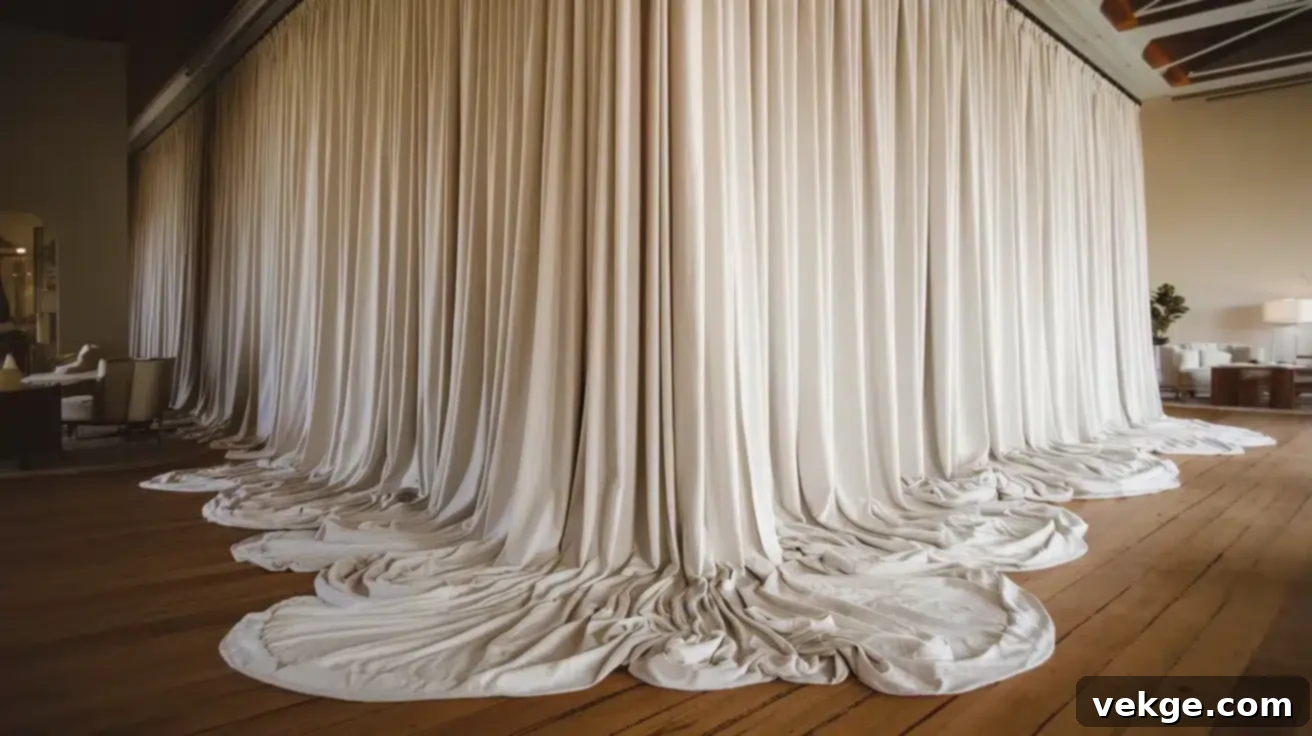
Puddle length allows curtains to fall several inches (typically 2 to 6 inches, or even more for a dramatic effect) beyond the floor, creating a soft, abundant “puddle” or cascade of fabric. This is the most luxurious and dramatic of all curtain lengths, designed to make a grand statement in any room.
Perfect for formal spaces, this style instantly adds an air of opulence, romance, and theatrical elegance. The excess fabric creates a sense of richness and extravagance, often associated with high-end interior design. Puddle length can also be incredibly forgiving, easily disguising uneven floors or wall-to-floor inconsistencies.
Ideal For:
- Formal Living Rooms and Dining Rooms: Where a grand and sophisticated atmosphere is desired.
- Master Bedrooms: To create a romantic, indulgent, and luxurious sanctuary.
- Decorative-Only Curtains: Best for windows where curtains are not frequently opened or closed.
- Bohemian or Shabby Chic Styles: Can add a relaxed, artistic, and soft texture.
- Concealing Flaws: Excellent for camouflaging uneven floor levels or crooked windows.
Choose this length for rooms where a grand, theatrical, or highly decorative look is desired. However, be mindful of the increased maintenance due to the excess fabric, as it can accumulate dust and dirt more easily. It also poses a potential tripping hazard if the puddle is too large in a high-traffic area. Regular fluffing and cleaning are recommended to maintain its elegant appearance.
4. Room-Specific Considerations

The optimal curtain length often varies significantly depending on the specific room and its primary function. What works beautifully in a formal dining room might be entirely impractical in a bustling kitchen. Considering the room’s purpose, size, and overall style is paramount when selecting the perfect curtain length for each individual space.
- Living Rooms and Dining Rooms: These are often public-facing areas where aesthetics and a refined look are crucial. Break length or even puddle length curtains are frequently preferred to create an elegant, sophisticated, and welcoming ambiance. They contribute to a sense of luxury and completeness.
- Bedrooms: For bedrooms, comfort, light control, and privacy are key. Break length curtains can enhance a cozy, intimate feel, while puddle length can add a touch of romantic drama. If blackout is a priority, ensure the curtains extend sufficiently beyond the window frame, regardless of the floor length, to minimize light leaks.
- Kitchens and Bathrooms: Functionality, hygiene, and resistance to moisture are important here. Shorter curtains, such as cafe curtains or float length drapes, are often more practical. They keep fabric away from sinks, counters, and potential splashes, making them easier to clean and preventing damage.
- Kids’ Rooms and Playrooms: Safety and durability are top concerns. Float length curtains are highly recommended to prevent tripping hazards and keep fabric out of reach of curious hands and playful pets. They are also easier to clean and maintain in active environments.
- Home Offices: A clean and focused environment is usually desired. Float or break length curtains can offer a professional look while still providing light control and privacy without being distracting.
Think about how you use the room daily. Do you need to open and close the curtains frequently? Is it a high-traffic area? Are there unique architectural features or furniture placements that influence the ideal length?
5. Fabric Type Matters
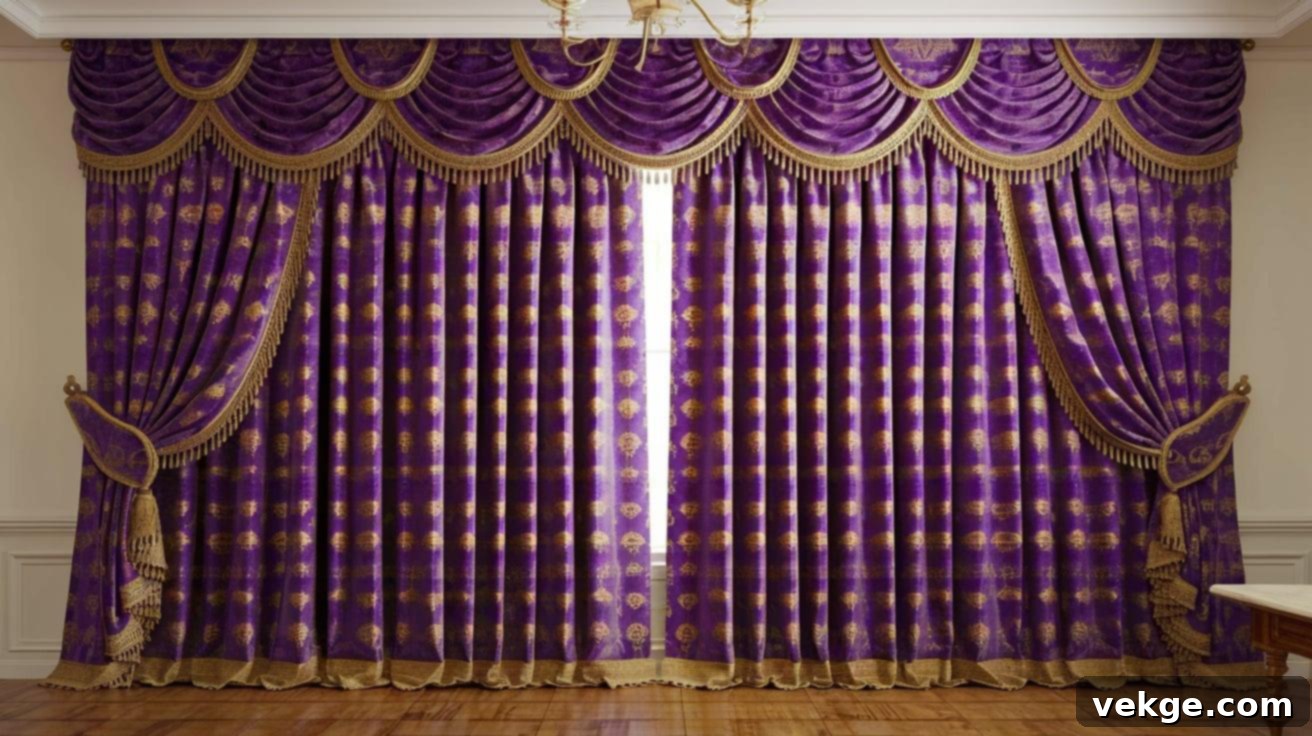
The choice of curtain length is significantly influenced by the fabric’s weight, texture, and inherent draping ability. Different materials behave differently when hung, and selecting a length that complements the fabric’s characteristics is essential for achieving the desired aesthetic and ensuring longevity.
- Heavier Fabrics (e.g., velvet, brocade, thick linen blends): These rich, substantial fabrics have a natural weight that causes them to hang beautifully. They can support a slight break or even a dramatic puddle, which enhances their luxurious appeal. However, extremely heavy fabrics with an excessive puddle can become very bulky and difficult to manage or clean. A careful balance is key.
- Lighter Fabrics (e.g., sheer, voile, lightweight linen, cotton): These fabrics are typically more airy and fluid. A float or break length often suits them best, allowing them to hang gracefully without looking messy. While a small puddle can work for a very relaxed, bohemian look, an overly large puddle with lightweight fabric might appear unstructured and less polished than with heavier materials.
- Stiff Fabrics (e.g., certain silks, very crisp cottons): Fabrics with more body or stiffness tend to hold their shape. For these, a float or break length is generally recommended to avoid awkward or unruly pooling at the bottom. A large puddle with a stiff fabric could look unnatural and lack the soft, flowing quality desired.
- Natural Fibers (e.g., linen, cotton, silk): Be mindful that natural fibers can sometimes shrink or stretch with humidity and cleaning. It’s often wise to pre-wash fabrics or allow extra length if you plan on washing them, or opt for a float or break length to account for minor fluctuations without affecting the overall look too drastically.
Consider the fabric’s natural drape and how it will interact with gravity. The goal is to choose a fabric and length combination that enhances both the aesthetic and practical needs of the room, ensuring your curtains hang beautifully for years to come.
6. Functionality Factor
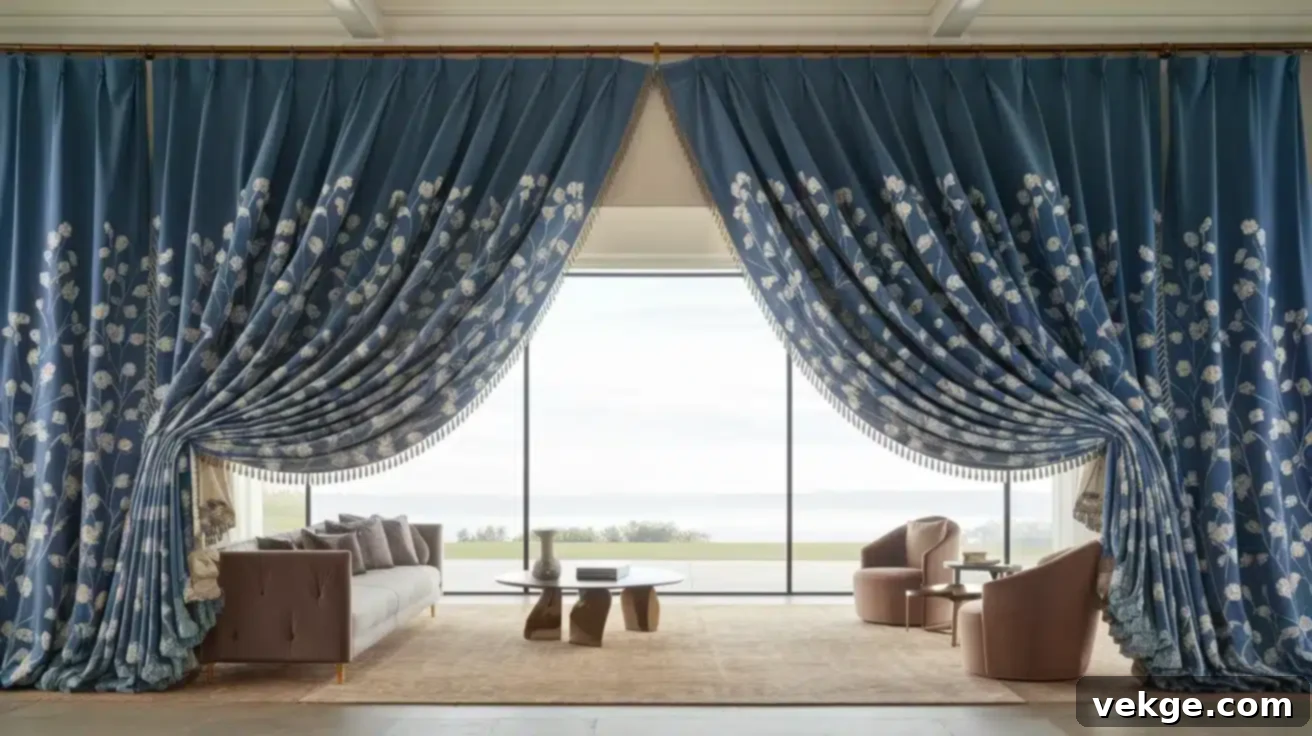
Beyond aesthetics, functionality plays a critical role in curtain length decisions. How you intend to use your curtains day-to-day should heavily influence your choice. A beautiful curtain that constantly gets in the way or collects dirt isn’t truly serving its purpose in your home.
- Ease of Use: In high-traffic areas or rooms where you frequently open and close the curtains (e.g., to access a balcony door or enjoy natural light), shorter lengths like float or a minimal break are far more practical. They glide smoothly along the rod or track without snagging or dragging, making daily operation effortless. Puddle length curtains, while stunning, can be cumbersome to manipulate daily.
- Cleaning and Maintenance: Curtains that touch or puddle on the floor are more prone to collecting dust, pet hair, and dirt. If you prefer low-maintenance window treatments or have allergies, float length curtains are a much more practical choice. Longer curtains will require more frequent cleaning, potentially including professional dry cleaning, especially for delicate fabrics.
- Safety: In homes with young children or pets, long puddle curtains can be a tripping hazard. Float length curtains eliminate this risk, contributing to a safer environment for everyone.
- Thermal Insulation: Longer curtains, particularly those with a slight break or puddle, can offer better thermal insulation. By sealing the gap between the window and the floor, they can help block drafts in colder months and keep warm air out during summer, contributing to energy efficiency. For maximum insulation, ensure curtains are lined or interlined.
- Blocking Light: Curtains that reach the floor generally do a better job of blocking light along the bottom edge of the window, which is particularly important for blackout curtains in bedrooms or media rooms.
Consider your lifestyle, the habits of your household members, and the demands of each room. The best curtain length is one that integrates seamlessly into your daily life, making your space both beautiful and practical.
7. Dealing With Uneven Floors

Homes, especially older ones, often feature floors that are not perfectly level. This can present a unique challenge when installing curtains, as a uniform length might result in curtains dragging unevenly in some spots while floating too high in others, creating an awkward and unpolished appearance.
When dealing with uneven floors, the float or break length often provides the most forgiving and visually consistent solution. By having the curtains just above or gently resting on the floor, slight variations in floor height are less noticeable compared to a dramatic puddle, which would accentuate the unevenness.
Tips for Uneven Floors:
- Measure at Multiple Points: Instead of taking just one measurement, measure the distance from the curtain rod to the floor at several points across the window. Identify the shortest and longest points.
- Choose the Shortest Point for Float: If opting for a float length, measure to the shortest point and then subtract 1/2 to 1 inch. This ensures the curtain won’t drag at any point.
- Consider a Slight Break for Forgiveness: For a break length, measure to the shortest point and add 1/2 inch to 1 inch. This will create a consistent “kiss” on the floor at the lowest point, and a slightly more pronounced break at higher points, which is often less noticeable than a floating gap.
- Custom Hems: For a truly tailored look, custom lengths may be necessary. A professional installer or seamstress can hem each curtain panel individually to accommodate the specific irregularities of your floor, ensuring a perfectly straight line at the bottom. This is especially useful for very long or wide windows.
- Puddle Length as a Camouflage: Ironically, in some extreme cases of unevenness, a generous puddle length can also work by simply having so much excess fabric that the unevenness is absorbed into the folds, making it less obvious. However, this is a more dramatic solution and still requires careful consideration.
Careful measurement and a thoughtful choice of length can ensure that your curtains look impeccably tailored, even in rooms with challenging floor conditions.
8. Blackout Curtain Considerations
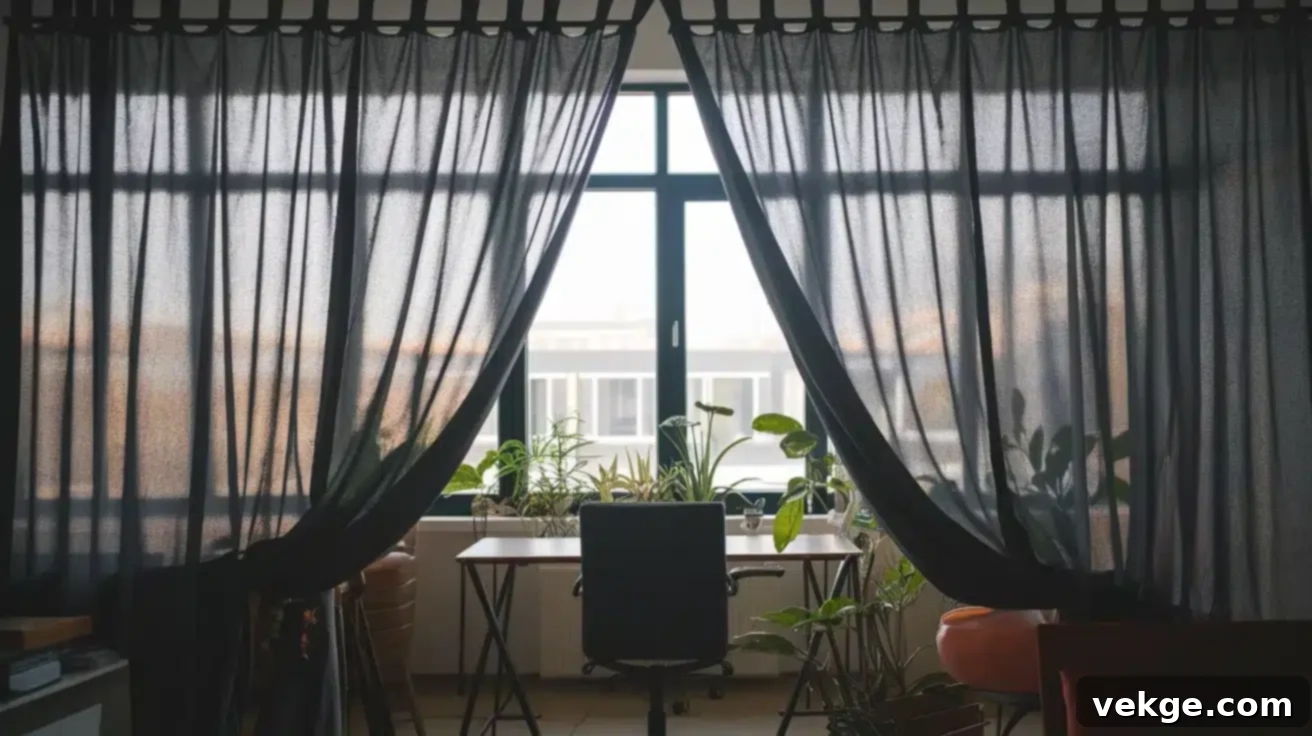
When it comes to blackout curtains, the primary goal is to effectively block out unwanted light, making length a crucial factor not just for aesthetics but for optimal performance. Blackout curtains must be long enough to completely cover the window and prevent any light leaks, ensuring a dark environment for sleeping, watching movies, or protecting interiors from harsh sunlight.
To achieve maximum light blockage, consider choosing a length that extends a few inches beyond the window frame on all sides—top, bottom, and sides. This “oversizing” helps to create a better seal and significantly reduces the amount of light that can seep in around the edges of the curtain. For the bottom edge, a break length or even a slight puddle can be highly effective, as the fabric resting on the floor helps to block any light that might otherwise escape from beneath the curtain.
Key Considerations for Blackout Curtain Length:
- Extend Past Window Frame: Ensure the curtains are wide enough to extend at least 6-12 inches past the window frame on each side, and long enough to extend at least 4-6 inches above the frame.
- Floor Contact: Opt for a break length (1/2 to 1 inch on the floor) or a small puddle (2-3 inches on the floor). This contact with the floor is vital for sealing off the bottom edge and preventing light from entering the room.
- Track vs. Rod: For superior blackout, consider a wrap-around curtain rod or a ceiling-mounted track system. These systems help to minimize light gaps at the top and sides, making the floor-length even more effective.
- Layering: In some cases, combining blackout curtains with sheer blinds or shades can offer even better light control and insulation, while also adding depth to your window treatment.
Prioritizing proper coverage ensures better functionality and significantly reduces light intrusion, providing a more effective blackout experience essential for bedrooms, nurseries, or media rooms.
It’s Okay to Break the Rules: Embracing Personal Style
While design principles and common trends offer excellent guidelines, it’s absolutely okay—and often encouraged—to break the standard curtain length rules to suit your unique space, personal aesthetic, or specific functional needs. Your home is a reflection of you, and sometimes, unconventional choices create the most impactful and authentic designs.
For instance, short curtains ending precisely at the window sill, though often considered outdated for living areas, can work perfectly in a charming country kitchen where a light, airy feel and easy access to a counter are priorities. Similarly, cafe-style curtains that cover only the bottom half of a window provide privacy while maximizing natural light, a functional choice that breaks traditional length rules but adds character.
Conversely, extra-long puddles that extend far beyond the standard 2-6 inches might create just the dramatic, bohemian, or opulent effect you want in a formal room or a creative studio space, even if they require more maintenance. For unusual window shapes, architectural quirks, or very specific functional requirements (like covering a rarely used door), traditional approaches might simply not make sense.
Trust your instincts and prioritize what truly makes you happy in your space. If you prefer curtains hanging a few inches above the floor for ultimate practicality, or if you desire more dramatic puddles than typically recommended for a unique design statement, then that is the right choice for your home. Your home should reflect your style and meet your needs, not be rigidly confined by universal design rules. Experiment, be creative, and choose the length that feels most beautiful and functional to you.
Conclusion: Finding Your Perfect Curtain Length
Deciding on the perfect curtain length is a nuanced process that balances aesthetic appeal with practical considerations. While general design trends often favor curtains that gracefully touch the floor for a polished and cohesive look, your ultimate choice should be a deeply personal one, tailored to your individual situation and preferences.
We’ve explored the three primary categories:
- Float Length: Ideal for modern, minimalist spaces, high-traffic areas, or homes with pets and children, offering a clean, maintenance-free look.
- Break Length: A versatile and classic choice for most rooms, providing a soft, elegant finish without significant maintenance issues, suitable for traditional and transitional styles.
- Puddle Length: The go-to for creating a luxurious, dramatic, and formal statement, best suited for decorative windows in master bedrooms or formal living spaces.
Beyond these styles, remember to meticulously consider your room type, the fabric’s weight and drape, and the overall functionality you require from your window treatments. Will you be opening and closing them frequently? Do you need maximum light blockage? Are there uneven floors or heating elements to work around?
Don’t be afraid to break conventional rules if it aligns better with your unique vision and lifestyle. Minor adjustments can always be made later if needed, ensuring your investment in window treatments truly enhances your living space.
Ultimately, the best curtain length is one that looks good to you, fits seamlessly into your daily life, and contributes to creating a space that feels both beautiful and inherently functional. Choose wisely, and enjoy the transformative power of perfectly hung curtains.
